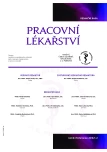Age management and the Working Ability Index – tools to support the employment of aging workers
Authors:
M. Petrovová 1; B. Pokorný 1
Authors‘ workplace:
Klinika pracovního lékařství Lékařská fakulta MU a FN USA Brno přednosta prof. MUDr. Petr Brhel, CSc.
1; Age Management, z. s., Brno předsedkyně spolku Mgr. Ilona Štorová
2
Published in:
Pracov. Lék., 70, 2018, No. 1-2, s. 38-44.
Category:
Review Article
Overview
The article deals with the employment of aging workers and with the processes necessary to retain their employability on the labor market. A suitable personal management tool is the awareness and implementation of the Age management rules and recommendation. The working ability of the employees plays a key role in the practical application of the Age Management rules. Good level of the working abilities is a necessary condition of the ongoing work performance by an individual. The Work Ability Index is used for quantitative assessment of the working ability of individual or collectives. The authors describe the methods, obtaining and assessment of information, and the use of individual and group results
Keywords:
age management – working ability – work ability index – WAI – ageing – older workers – labor care – occupational medical care
Sources
1. Cimbálníková, L. Age Management: komparativní analýza podmínek a přístupů využívaných v České republice a ve Finsku. Praha: AIVD ČR, 2011. ISBN 978-80-904531-2-8.
2. Cimbálníková, L., Fukan, J., Lazarová, B. et al. Age Management pro práci s cílovou skupinou 50+: Metodická příručka Asociace institucí vzdělávání dospělých ČR, Praha: AIVD, 2012. ISBN 978-80-904531-5-9.
3. Čevela, R., Kalvach, Z., Čeledová, L. Sociální gerontologie: úvod do problematiky. Praha: Grada Publishing, 2012.
4. de Zwart, B. C., Frings-Dresen, M. H., van Duivenbooden, J. C. Test – retest reliability of the Work Ability Index questionnaire. Occup Med, 2002, 52, 4, s. 177–181.
5. Gould, R., Ilmarinen, J., Järvisalo, J., Koskinen, S. Dimensions of work ability: results of the Health 2000 survey. Helsinki: Finnish Centre for Pensions, The Social Insurance Institution, National Public Health Institute, Finnish Institute of Occupational Health; 2008.
6. Ilmarinen, J., Tuomi, K., Klockars, M. Changes in the work ability of active employees over an 11-year period. Scand J Work Environ Health, 1997, 23, suppl 1, s. 49–57.
7. Ilmarinen, J. 30 years’ work ability and 20 years’ age management. In: Age management during the life course: proceedings of the 4th symposium on work ability. Tampere: 2011 University Press, 2011, s. 12–21.
8. Ilmarinen, J. The Work Ability Index (WAI). Occup Med, 2007, 57, 2, s. 160.
9. Ilmarinen, J. Podpora aktivního stárnutí na pracovišti [online]. Evropská agentura pro bezpečnost a ochranu zdraví při práci. (2012). [cit. 14.01.2018]. Dostupné z www: https://osha.europa.eu/cs/tools-and-publications/publications/articles /promoting-active-ageing-in-the-workplace/view.
10. Kalousová, P., Štern, P., Žákavec, J., Zábrženská, M. Age management: jak řídit a rozvíjet lidské zdroje v kontextu věku a demografických změn. 1. vyd. Praha: Konfederace zaměstnavatelských a podnikatelských svazů ČR, 2015. ISBN 978-80-260-8019-0.
11. Kujala, V., Tammelin, T., Remes, J. et al. Work ability index of young employees and their sickness absence during the following year. Scand J Work Environ Health 2006, 32, 1, p. 75–84.
12. Kumashiro, M., Kadoya, M., Kubota, M. et al. The relationship between work ability index, exercise habits, and occupational stress – employees with good exercise habits have greater work ability. In: Age management during the life course: proceedings of the 4th symposium on work ability. Tampere: Tampere University Press; 2011.
13. Laurier, J., Schilder, L., Hupkens, L. Het Nederlands werkvermogen 2013. [online]. [cit 14-01-2018]. Dostupné z www: https://www.blikopwerk.nl/doc/media/HetNederlandseWerkvermogen2013.pdf
14. Novotný, P., Bosničová, N., Břenková J. et al. Age management: jak rozumět stárnutí a jak na něj reagovat: možnosti uplatnění age managementu v České republice: průvodce pro jednotlivce, organizace a společnost. 1. vyd. Plzeň: AIVD ČR, 2014. ISBN 978-80-904531-7-3.
15. OECD. Review from 2011 to 2014. Live Longer, WorkLonger: A Synthesis Report of the Agein and Employment Policies. Project. Paris: OECD, 2006.
16. Reeuwijk, K. G., Robroek, S. J. W., Niessen et al. The prognostic value of the work ability index for sickness absence among office workers. PLoS One, 2015, 10, 5.
17. Štorová, I., Fukan, J. Zaměstnanec a věk, aneb age management na pracovišti. Jena, Šumperk, 2012, 79 s.
18. Štorová, I. Age management pro zaměstnavatele se zaměřením na starší pracovníky. Praha, Svaz průmyslu a dopravy ČR, 2015.
19. Tuomi, K., Ilmarinen, J., Jahkola, A. et al. Work Ability Index (2nd rev. ed) Helsinki, Finnish Institute of Occupational Health, 1998.
20. Tuomi, K. J., Ilmarinen, J., Seitsamo et al. Summary Of The Finnish Research Project (1981–1992) To Promote The Health And Work Ability Of Aging Workers. Scandinavian Journal Of Work, Environment & Health, 1997, 23, Suppl 1, s. 66–71.
Labels
Hygiene and epidemiology Hyperbaric medicine Occupational medicineArticle was published in
Occupational Medicine

2018 Issue 1-2
Most read in this issue
- Leptospirosis viewed by a general practitioner – case report
- TSI – Teacher Stress Inventory: Validation of the Slovak version
-
Evaluation of local muscular load in female stitchers of car coating
1st Part: the use of a modified Nordic Questionnaire - Work ability index among ageing Czech Republic workers
